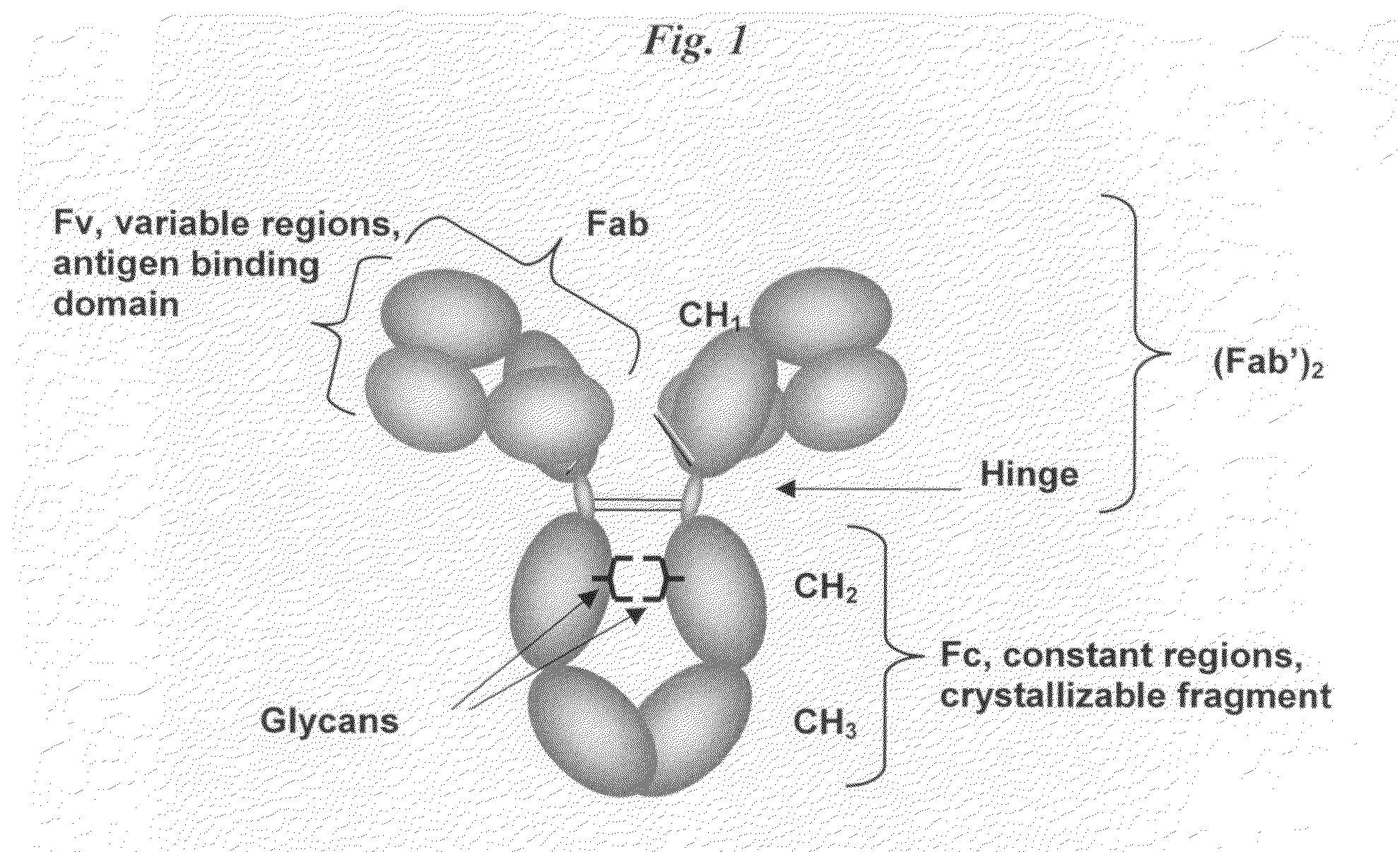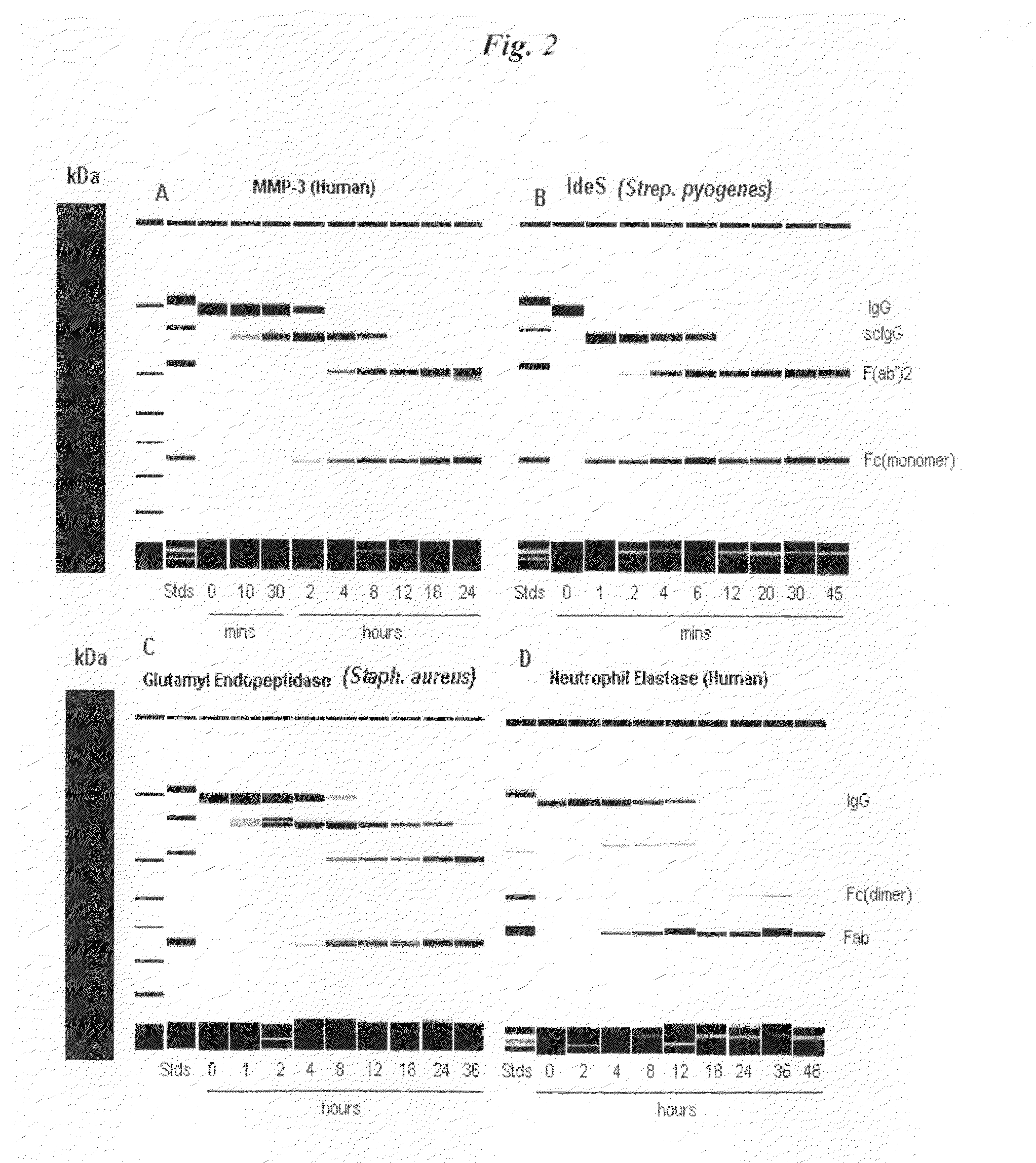Immunoglobulin Cleavage Fragments as Disease Indicators and Compositions for Detecting and Binding Such
- Summary
- Abstract
- Description
- Claims
- Application Information
AI Technical Summary
Benefits of technology
Problems solved by technology
Method used
Image
Examples
example 1
Cleavage Analysis of Human IgG Heavy Chain
[0063]Proteolysis of human IgG heavy chain by matrix metalloproteinases, cathepsins, human neutrophil elastase (HNE), and selected pathogen enzymes such as staphylococcal glutamyl endopeptidase (V8 protease), and immunoglobulin degrading enzyme of streptococcus (IdeS) was studied.
[0064]A purified monoclonal antibody comprising a human IgG heavy chain was contacted with the proteases described and sampling was conducted over various durations of contact. Fragmentation in the samples was evaluated using the Agilent microfluidics “lab-on-a-chip” technology for in vitro biosizing (Goetz H et al. Biochemical and Biophysical Methods 60; 281-293, 2004).
[0065]Antibody Substrates. Monoclonal antibodies were either fully human, recombinant humanized murine antibodies or human / murine chimeric antibodies possessing human constant domains and hinge regions of the IgG1kappa class / subclass and species: Mab1 is a human IgG1 which binds a pathogen, Mab2 (ant...
example 2
Cleavage of IgG in an Inflammatory Exudate
[0081]Inflammatory exudates and other such fluids are expected to possess proteolytic enzymes associated with the inflammation and wound healing. For this purpose, samples of wound fluid were obtained from Ethicon Inc.
[0082]First, an antibody substrate, which comprises human heavy chain constant domains was randomly biotinylated. Ten microliters of the biotinylated substrate antibody was added to 190 microL of the wound fluid and incubated at 37° C. for 8-24 hours. At specified times, samples were removed. The starting IgG and samples from the various times were applied in separate wells to a 4-12% Bis-Tris gel and subjected to SDS PAGE. The separated bands were transferred to a nitrocellulose membrane and, following blocking with 0.1M Tris buffered saline containing 0.1% Tween 20 and 10% blocking grade milk (“Blotto”), the blot was developed using AVIDIN-D-horseradish peroxidase reagent followed by TMB (membrane) substrate.
[0083]As evidence...
example 3
Preparation of Reagent
[0084]The determination of the presence of host (patient) antibody fragments produced by endogenous proteases requires a reagent which selectively binds to the cleaved IgG but not intact IgG. Both identification of the cleaved component and a quantitative difference between fragment content in samples from patients with disease as compared to the normal population should be able to be assessed using the reagent.
[0085]The detection of unknown, but likely small amounts of IgG fragments in solutions containing relatively high concentrations of intact IgG is difficult. Although scIgG has been noted as a possible IgG cleavage fragment (Gearing 2002 supra), quantitation in human samples has not been previously performed. For this purpose, a reagents with the necessary specificity were generated in rabbits having with a high degree of specificity for cleaved but not intact IgG.
[0086]Three conjugated, and progressively longer single-chain peptide analogs of the human I...
PUM
| Property | Measurement | Unit |
|---|---|---|
| molecular weight | aaaaa | aaaaa |
| concentration | aaaaa | aaaaa |
| molecular weight | aaaaa | aaaaa |
Abstract
Description
Claims
Application Information
 Login to View More
Login to View More - R&D
- Intellectual Property
- Life Sciences
- Materials
- Tech Scout
- Unparalleled Data Quality
- Higher Quality Content
- 60% Fewer Hallucinations
Browse by: Latest US Patents, China's latest patents, Technical Efficacy Thesaurus, Application Domain, Technology Topic, Popular Technical Reports.
© 2025 PatSnap. All rights reserved.Legal|Privacy policy|Modern Slavery Act Transparency Statement|Sitemap|About US| Contact US: help@patsnap.com



